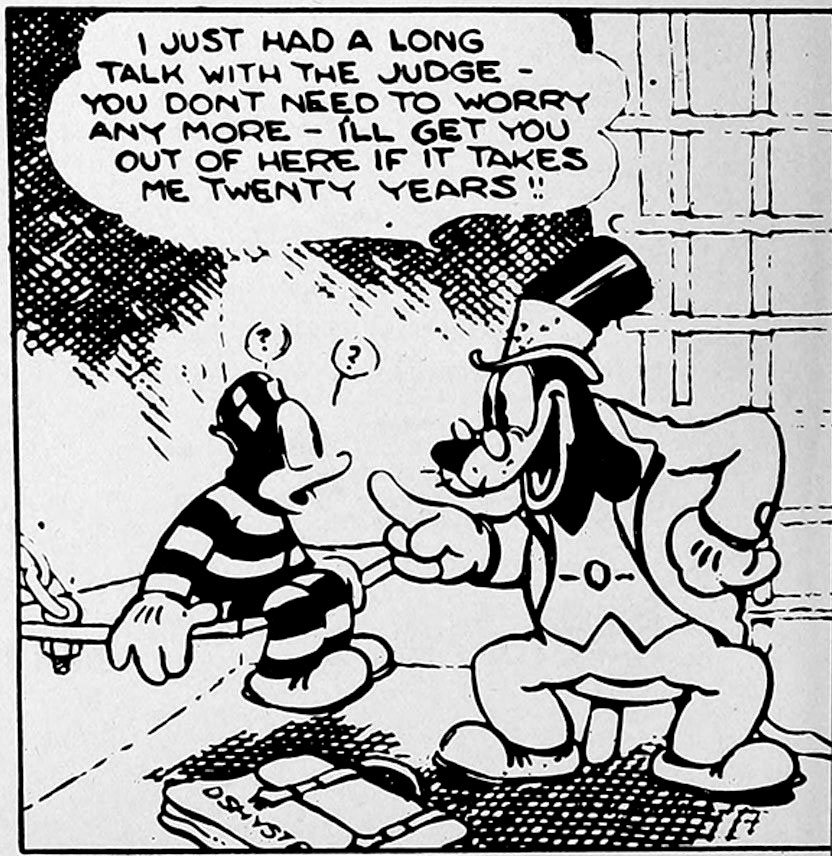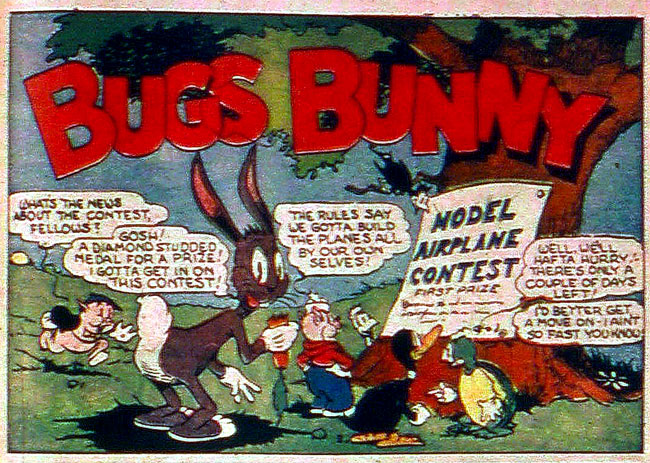'Penguin Pete', from Popular Comics #50, April 1940.
Win Smith was a Canadian-American animator and comic artist, best remembered for being the second artist to draw the 'Mickey Mouse' newspaper comic, which he did between February and May 1930. At Dell Comics, he was the creator of 'Penguin Pete' and 'Looney Luke', and also one of the first artists to draw comic book stories based on 'Bugs Bunny'.
Early life and career
Winfield Frank Smith was born in 1887 in Wallaceburg, Ontario, Canada. His father was a watchmaker who later moved to St. Paul, Minnesota. As an adult, Smith settled in Santa Ana, California, where he naturalized himself as a U.S. citizen. During the First World War he was drafted. Back in civilian life, he worked as a self-employed jeweler, advertising illustrator and newspaper cartoonist. Moving to Santa Monica, California, he found a job as an animator with the Walt Disney Studios. Diane Disney Miller once claimed that Win Smith was the inventor of the storyboard, but she confused him with another Disney employee, Webb Smith.
'Mickey Mouse' newspaper strip of 25 April 1930.
Mickey Mouse newspaper comic
Mickey Mouse was already a global sensation when Walt Disney and his top animator Ub Iwerks launched a 'Mickey Mouse' newspaper comic on 13 January 1930. The first story, 'Lost on a Desert Island', was scripted by Disney himself, with Iwerks penciling the episodes and Win Smith providing inking. As everyone expected, the comic was instantly popular and, thanks to the King Features Syndicate, easily found distribution across the planet. But a month later, Iwerks had a fall-out with Disney and left the company, leaving the 'Mickey' comic in the hands of Win Smith from 8-10 February 1930 on. Smith completed the first story, while Floyd Gottfredson and Jack King assisted and inked. On 1 April 1930, they started a second story, 'Mickey Mouse in Death Valley'. Interviewed by Don Peri, Gottfredson recalled that Win Smith drew with his right hand, but wrote with his left.
Around this time, Walt Disney became too preoccupied with his animation studio to keep an eye on the comic strip. He wanted a reliable cartoonist who could both write and draw the new episodes, so he could leave it all in safe hands. Smith was asked to be that person, but refused. History has not recorded his motivation. Either he felt he lacked the inspiration or energy or he just didn't want to do it. What is certain is that Smith was already 42 at that point, while Disney was 27 and strongly pressuring him to obey his orders. Gottfredson recalled that Disney once called Smith to his office where they had a showdown: "In about a half hour, Win came storming out to my desk and said, 'It looks like you got a new job.' I said, 'Why is this?' He said, 'No young whippersnapper is going to tell me what to do,' and he walked out of the studio into oblivion."
Indeed, on 17 May 1930, Gottfredson succeeded Smith as the lead cartoonist on the 'Mickey' feature, though they assured him that it would only be a "temporary fill-in job". Other artists filled in on episodes as well, such as Jack King, Hardie Gramatky and Roy Nelson. But as it turned out, Gottfredson was actually the perfect candidate, because he was equally talented in both writing, drawing and inking. So, in an ironic fashion, he continued the series for the next four decades.
Unpublished 'Flip the Frog' strip, drawn by Win Smith (around 1931).
Iwerks
In 1930, former Walt Disney right hand Ub Iwerks left the Walt Disney Company to establish his own animation studio. Between 1930 and 1936, he produced several animated cartoons and tried to launch his own stars, such as the happy amphibian 'Flip the Frog' (1931-1933). Around this time, Win Smith was one of Iwerks' employees. He once made some sample episodes of a 'Flip the Frog' newspaper comic. In the biographical entry about Win Smith, printed in the first Fantagraphics collection of 'Mickey Mouse' newspaper comics, Disney historian David Gerstein estimates that this comic strip might have been drawn in 1931. About five years after the 'Flip the Frog' comic was created, single panels from it were used to advertise 16mm releases of some of the animated shorts. These were small copies of film rolls, usually featuring one short picture, and could be described as forerunners of the home video. However, at the time, Iwerks' cartoons were not that popular, and Smith's comic strips never went into circulation. Most distributors of animated shorts and comics were more interested in 'Mickey Mouse' cartoons, given their tremendous commercial possibilities. In the United Kingdom, Dean & Son Ltd., is the only known publisher to have brought out a 'Flip the Frog' comic book, namely the 'Flip the Frog Annual' (1931), drawn by local artist Wilfred Haughton. The 'Flip the Frog' animated series was discontinued in 1933 and three years later,. Iwerks closed down his studio.
Warner Bros.
In the first half of the 1930s, Win Smith joined the brand new animation studio at Warner Brothers, founded by Hugh Harman and Rudolph Ising. In the previous years, Warners launched several animated series, such as 'Bosko' (1929-1933), which was adapted into a newspaper comic version in 1934. The comic strip was credited to Hugh Harman and Rudolf Ising, but actually drawn by Robert Allen and later Win Smith. The feature was typically a story starring Bosko, with at the bottom a companion strip, usually a drawing lesson under the title 'How to Draw Animated Cartoon Characters'. Interestingly enough, the comic followed the text comics format, with narration in captions underneath the images. The first 66 episodes were stand alone gags, after which the feature evolved into a serialized story under the title 'Bosko on Cannibal Isle'.
'Bugs Bunny', Looney Tunes and Merrie Melodies Comics, Dell Comics, 1941.
Comic books
By the end of the 1930s, Warner Brothers' animation studio finally had real cartoon stars with Daffy Duck (1937) and Bugs Bunny (1940), both created by Tex Avery. In 1941, when Avery left Warners, producer Leon Schlesinger licensed Western Publishing to launch comic books based on the Looney Tunes characters. Win Smith had been a comic book artist for Western's Dell Comics line since 1939, drawing and creating the funny animal feature 'Penguin Pete' (AKA 'Penguin Pete and his Pal Pudgie' or 'Pete and Pudgie') for Popular Comics and The Funnies (1930-1940). He also drew stories with 'The O'Malley Kids' in Super Comics and 'Times Marches Back with Looney Luke' in Crackajack Funnies. In the first issue of 'Looney Tunes and Merrie Melodies Comics' (Dell, 1941), Smith wrote and drew an eight-page 'Bugs Bunny' story, and also contributed another story that lacked the familiar Looney Tunes characters, 'Cannibalism and a Roonga'. Instead, the heroes were 'Pat, Patsy and Pete', two kids who traveled the world with a talking penguin, modeled after Smith's earlier Penguin Pete character. Smith later passed the pencil to Walt Kelly. As 'Pat, Patsy and Pete' was his own creation, Smith's feature was the only one signed by the artist in the 'Looney Tunes' comic books.
Walter Lantz
In the late 1930s, Smith was also active for Walter Lantz' animation studio, writing stories for 'Oswald the Lucky Rabbit'. The character was originally created by Walt Disney and Ub Iwerks in 1928.
Death
Win Smith passed away in 1941 in Los Angeles, California. At the time of his death, he was a drawing teacher at Phoenix High School.









